
Master the AZ-102 Exam Questions and Answers content and be ready for exam day success quickly with this AZ-102 Dumps. We guarantee it!We make it a reality and give you real AZ-102 Dumps Questions in our Microsoft AZ-102 braindumps. Latest 100% VALID AZ-102 Exam Dumps at below page. You can use our Microsoft AZ-102 braindumps and pass your exam.
Also have AZ-102 free dumps questions for you:
NEW QUESTION 1
Your company registers a domain name of contoso.com.
You create an Azure DNS named contoso.com and then you add an A record to the zone for a host named www that has an IP address of 131.107.1.10.
You discover that Internet hosts are unable to resolve www.contoso.com to the 131.107.1.10 IP address.
You need to resolve the name resolution issue.
Solution: You add an NS record to the contoso.com zone. Does this meet the goal?
Answer: A
Explanation: Before you can delegate your DNS zone to Azure DNS, you need to know the name servers for your
zone. The NS record set contains the names of the Azure DNS name servers assigned to the zone. References: https://docs.microsoft.com/en-us/azure/dns/dns-delegate-domain-azure-dns
NEW QUESTION 2
You need to deploy an application gateway named appgwl015 to meet the following requirements: Load balance internal IP traffic to the Azure virtual machines connected to subnet0.
Provide a Service Level Agreement (SLA) of 99.99 percent availability for the Azure virtual machines. What should you do from the Azure portal?
Answer:
Explanation: Step 1:
Click New found on the upper left-hand corner of the Azure portal. Step 2:
Select Networking and then select Application Gateway in the Featured list. Step 3:
Enter these values for the application gateway: appgw1015 - for the name of the application gateway. SKU Size: Standard_V2
The new SKU [Standard_V2] offers autoscaling and other critical performance enhancements.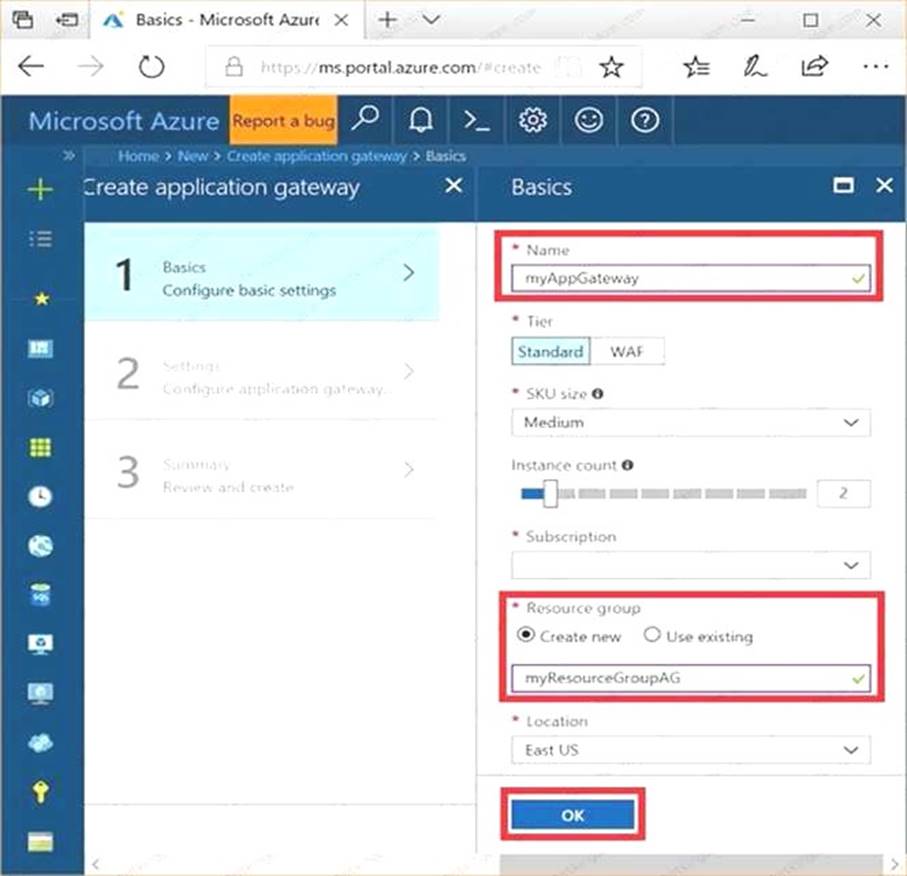
Step 4:
Accept the default values for the other settings and then click OK. Step 5:
Click Choose a virtual network, and select subnet0.
References:
https://docs.microsoft.com/en-us/azure/application-gateway/application-gateway-create-gatewayportal
NEW QUESTION 3
You are configuring serverless computing in Azure.
You need to receive an email message whenever a resource is created in or deleted from a resource group. Which three actions should you perform in sequence? To answer, move the appropriate actions from the list of actions to the answer area and arrange them in the correct order.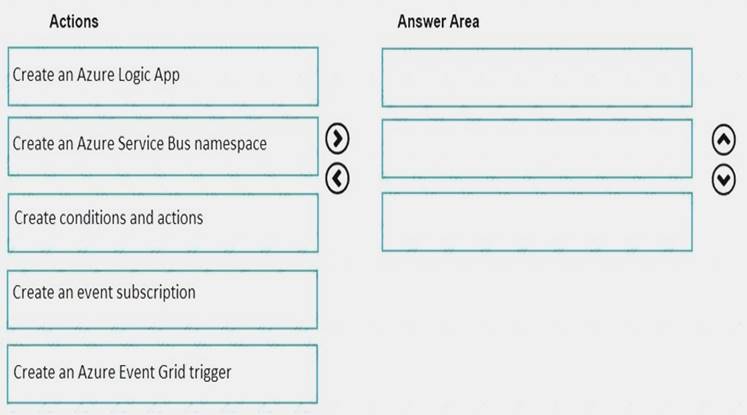
Answer:
Explanation: Step 1: Create an event subscription
When you subscribe to events for a resource group, your endpoint receives all events for that resource group. Step 2: Create an Azure Event Grid trigger
Step 3: Create conditions and actions References:
https://docs.microsoft.com/en-us/azure/event-grid/event-schema-resource-groups
NEW QUESTION 4
HOT SPOT
You have a virtual network named VNet1 that has the configuration shown in the following exhibit.
Use the drop-down menus to select the answer choice that completes each statement based on the information presented in the graphic.
NOTE: Each correct selection is worth one point.
Answer:
Explanation: Box 1: add a subnet
Your IaaS virtual machines (VMs) and PaaS role instances in a virtual network automatically receive a private IP address from a range that you specify, based on the subnet they are connected to. We
need to add the 192.168.1.0/24 subnet. Box 2: add a network interface
The 10.2.1.0/24 network exists. We need to add a network interface.
References: https://docs.microsoft.com/en-us/azure/virtual-network/virtual-networks-static-privateip- arm-pportal
NEW QUESTION 5
HOT SPOT
You need to prepare the environment to implement the planned changes for Server2. What should you do? To answer, select the appropriate options in the answer area. NOTE: Each correct selection is worth one point.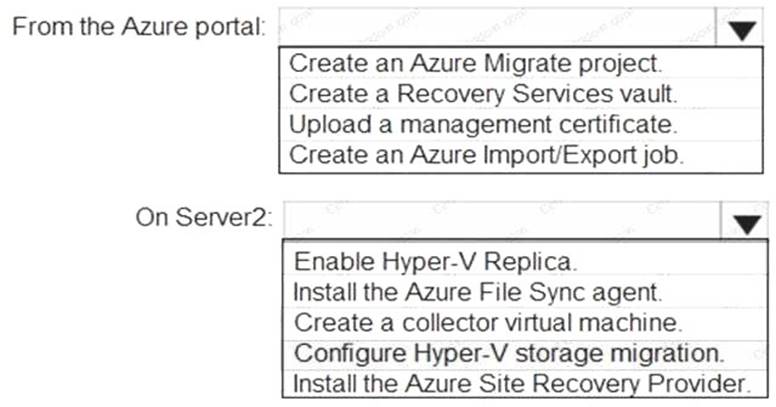
Answer:
Explanation: Box 1: Create a Recovery Services vault
Create a Recovery Services vault on the Azure Portal. Box 2: Install the Azure Site Recovery Provider
Azure Site Recovery can be used to manage migration of on-premises machines to Azure. Scenario: Migrate the virtual machines hosted on Server1 and Server2 to Azure.
Server2 has the Hyper-V host role. References:
https://docs.microsoft.com/en-us/azure/site-recovery/migrate-tutorial-on-premises-azure
Case Study: 8
Mix Questions Set C (Evaluate and perform server migration to Azure)
NEW QUESTION 6
HOT SPOT
You have an Azure subscription named Subscription1 that contains the resources in the following table.
VM1 and VM2 run the websites in the following table.
AppGW1 has the backend pools in the following table.
DNS resolves site1.contoso.com, site2.contoso.com, and site3.contoso.com to the IP address of AppGW1.
AppGW1 has the listeners in the following table.
AppGW1 has the rules in the following table.
For each of the following statements, select Yes if the statement is true. Otherwise, select No. NOTE: Each correct selection is worth one point.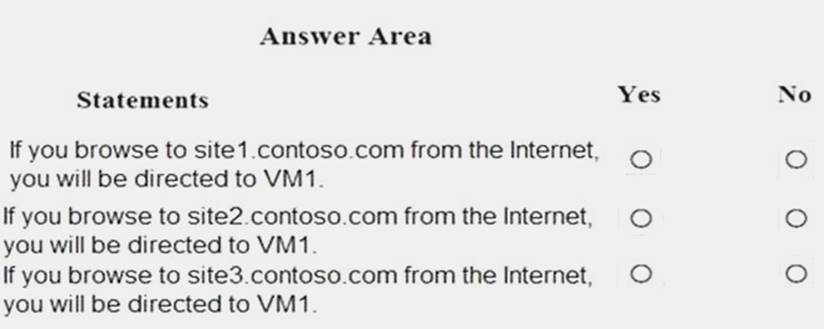
Answer:
Explanation: Vm1 is in Pool1. Rule2 applies to Pool1, Listener 2, and site2.contoso.com
NEW QUESTION 7
HOT SPOT
You have an Azure subscription named Subscroption1. In Subscription1, you create an alert rule named Alert1.
The Alert1 action group is configured as shown in the following exhibit.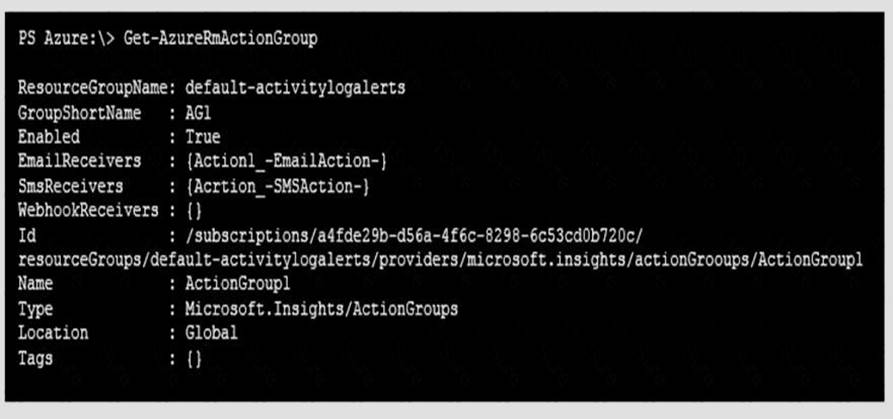
Alert1 alert criteria is triggered every minute.
Use the drop-down menus to select the answer choice that completes each statement based on the information presented in the graphic.
NOTE: Each correct selection is worth one point.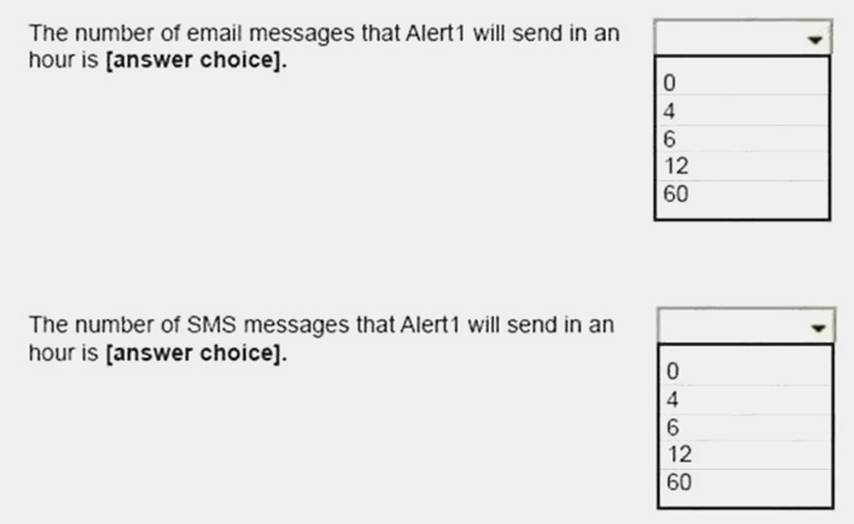
Answer:
Explanation: Box 1: 60
One alert per minute will trigger one email per minute. Box 2: 12
No more than 1 SMS every 5 minutes can be send, which equals 12 per hour.
Note: Rate limiting is a suspension of notifications that occurs when too many are sent to a particular phone number, email address or device. Rate limiting ensures that alerts are manageable and actionable.
The rate limit thresholds are:
SMS: No more than 1 SMS every 5 minutes. Voice: No more than 1 Voice call every 5 minutes. Email: No more than 100 emails in an hour. Other actions are not rate limited.
References:
https://github.com/MicrosoftDocs/azure-docs/blob/master/articles/monitoring-anddiagnostics/ monitoring-overview-alerts.md
NEW QUESTION 8
DRAG DROP
You need to prepare the environment to ensure that the web administrators can deploy the web apps as quickly as possible.
Which three actions should you perform in sequence? To answer, move the appropriate actions from the list of actions to the answer area and arrange them in the correct order.
Answer:
Explanation:
Step 1:
First you create a storage account using the Azure portal.
Step 2:
Select Automation options at the bottom of the screen. The portal shows the template on the Template tab.
Deploy: Deploy the Azure storage account to Azure. Step 3:
Share the template.
Scenario: Web administrators will deploy Azure web apps for the marketing department. Each web app will be added to a separate resource group. The initial configuration of the web apps will be identical. The web administrators have permission to deploy web apps to resource groups.
References: https://docs.microsoft.com/en-us/azure/azure-resource-manager/resource-managerquickstart-create-templates-use-the-portal
NEW QUESTION 9
Your company recently hired a user named janet-7509087@ExamUsers.com.
You need to ensure that janet-7509087@ ExamUsers.com can connect to load balancer named Web- LAB. The solution must ensure that janet-7509087@ ExamUsers.com can modify the backend pools. What should you do from the Azure portal?
Answer:
Explanation: Step 1:
In the navigation list, choose Load Balancer.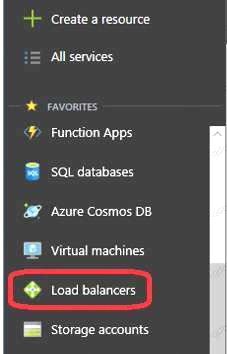
Step 2:
Locate the load balancer named Web-ALB, and click the Access icon. Step3:
In the Users blade, click Roles. In the Roles blade, click Add to add permissions for the user Janet- 7509087@ExamUsers.com.
Step 4:
Add permission to modify backend pools References:
https://docs.microsoft.com/en-us/azure/azure-stack/azure-stack-manage-permissions
NEW QUESTION 10
DRAG DROP
Your network is configured as shown in the following exhibit.
The firewalls are configured as shown in the following table.
Prod1 contains a vCenter server.
You install an Azure Migrate Collector on Test1. You need to discover the virtual machines.
Which TCP port should be allowed on each firewall? To answer, drag the appropriate ports to the correct firewalls. Each port may be used once, more than once, or not at all. You may need to drag the split bar between panes or scroll to view content.
NOTE: Each correct selection is worth one point.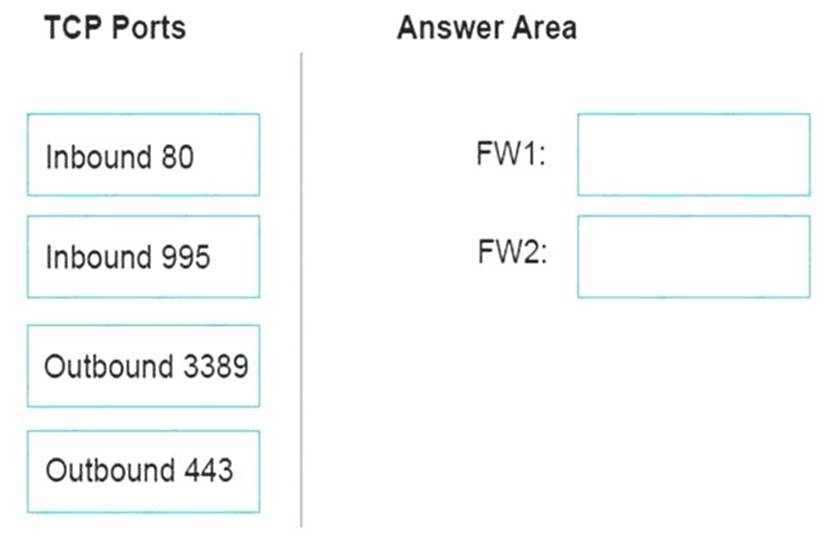
Answer:
Explanation: FW1: Outbound 443
Collector communicates with Azure Migrate service over SSL 443. FW2: Outbound 443
The Collector must be able to communicate with the vCenter Server. By default, it connects to vCenter on 443.
Note: The collector communicates as summarized in the following diagram.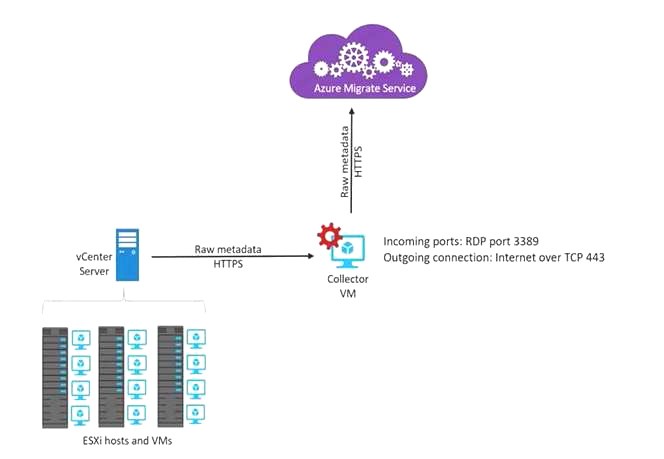
References:
https://docs.microsoft.com/en-us/azure/migrate/concepts-collector
NEW QUESTION 11
DRAG DROP
You have two Azure virtual machines named VM1 and VM2. VM1 has a single data disk named Disk1. You need to attach Disk1 to VM2. The solution must minimize downtime for both virtual machines.
Which four actions should you perform in sequence? To answer, move the appropriate actions from the list of actions to the answer area and arrange them in the correct order.
Answer:
Explanation: Step 1: Stop VM1.
Step 2: Detach Disk1 from VM1. Step 3: Start VM1.
Detach a data disk using the portal
In the left menu, select Virtual Machines.
Select the virtual machine that has the data disk you want to detach and click Stop to deallocate the
VM.
In the virtual machine pane, select Disks. At the top of the Disks pane, select Edit.
In the Disks pane, to the far right of the data disk that you would like to detach, click the Detach button image detach button.
After the disk has been removed, click Save on the top of the pane.
In the virtual machine pane, click Overview and then click the Start button at the top of the pane to restart the VM.
The disk stays in storage but is no longer attached to a virtual machine. Step 4: Attach Disk1 to VM2
Attach an existing disk
Follow these steps to reattach an existing available data disk to a running VM. Select a running VM for which you want to reattach a data disk.
From the menu on the left, select Disks.
Select Attach existing to attach an available data disk to the VM. From the Attach existing disk pane, select OK.
References:
https://docs.microsoft.com/en-us/azure/virtual-machines/windows/detach-disk https://docs.microsoft.com/en-us/azure/lab-services/devtest-lab-attach-detach-data-disk
NEW QUESTION 12
You download an Azure Resource Manager template based on an existing virtual machine. The template will be used to deploy 100 virtual machines.
You need to modify the template to reference an administrative password. You must prevent the password from being stored in plain text.
What should you create to store the password?
Answer: C
Explanation: You can use a template that allows you to deploy a simple Windows VM by retrieving the password that is stored in a Key Vault. Therefore the password is never put in plain text in the template parameter file.
References: https://azure.microsoft.com/en-us/resources/templates/101-vm-secure-password/
NEW QUESTION 13
DRAG DROP
You have an on-premises network that includes a Microsoft SQL Server instance named SQL1. You create an Azure Logic App named App1.
You need to ensure that App1 can query a database on SQL1.
Which three actions should you perform in sequence? To answer, move the appropriate actions from the list of actions to the answer area and arrange them in the correct order.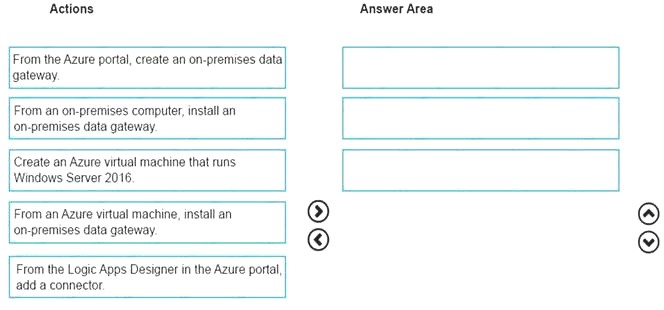
Answer:
Explanation: To access data sources on premises from your logic apps, you can create a data gateway resource in Azure so that your logic apps can use the on-premises connectors.
Box 1: From an on-premises computer, install an on-premises data gateway.
Before you can connect to on-premises data sources from Azure Logic Apps, download and install the on-premises data gateway on a local computer.
Box 2: From the Azure portal, create an on-premises data gateway Create Azure resource for gateway
After you install the gateway on a local computer, you can then create an Azure resource for your gateway. This step also associates your gateway resource with your Azure subscription.
Sign in to the Azure portal. Make sure you use the same Azure work or school email address used to install the gateway.
On the main Azure menu, select Create a resource > Integration > On-premises data gateway.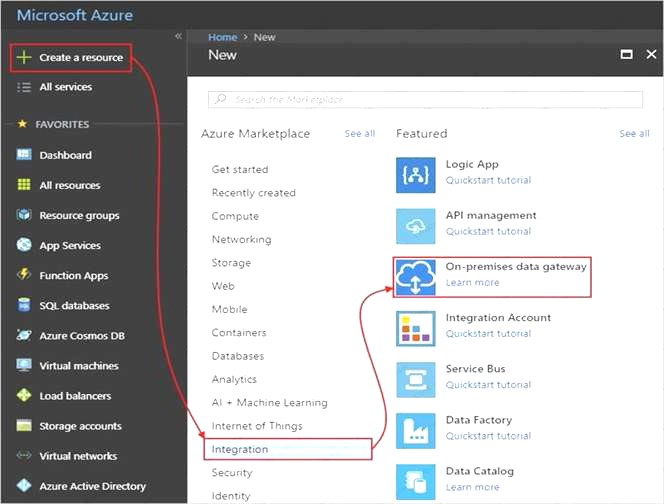
On the Create connection gateway page, provide this information for your gateway resource.
To add the gateway resource to your Azure dashboard, select Pin to dashboard. When you're done, choose Create.
Box 3: From the Logic Apps Designer in the Azure portal, add a connector
After you create your gateway resource and associate your Azure subscription with this resource, you can now create a connection between your logic app and your on-premises data source by using the gateway.
In the Azure portal, create or open your logic app in the Logic App Designer. Add a connector that supports on-premises connections, for example, SQL Server. Set up your connection.
References:
https://docs.microsoft.com/en-us/azure/logic-apps/logic-apps-gateway-connection
NEW QUESTION 14
HOT SPOT
You have an Azure Migrate project that has the following assessment properties: Target location: East US
Storage redundancy: Locally redundant. Comfort factor: 2.0
Performance history: 1 month Percentile utilization: 95th
Pricing tier: Standard Offer: Pay as you go
You discover the following two virtual machines:
A virtual machine named VM1 that runs Windows Server 2021 and has 10 CPU cores at 20 percent utilization
A virtual machine named VM2 that runs Windows Server 2012 and has four CPU cores at 50 percent utilization
How many CPU cores will Azure Migrate recommend for each virtual machine? To answer, select the appropriate options in the answer area.
NOTE: Each correct selection is worth one point.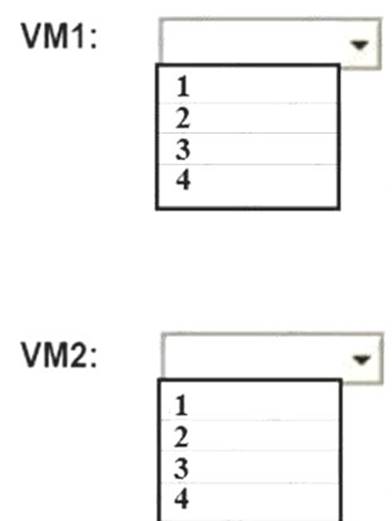
Answer:
Explanation: Box 2: 4
4 *0.50 * 0.95* 2 = 3.8
Note: The number of cores in the machines must be equal to or less than the maximum number of cores (128 cores) supported for an Azure VM.
If performance history is available, Azure Migrate considers the utilized cores for comparison. If a comfort factor is specified in the assessment settings, the number of utilized cores is multiplied by the comfort factor.
If there's no performance history, Azure Migrate uses the allocated cores, without applying the comfort factor.
References:
https://docs.microsoft.com/en-us/azure/migrate/concepts-assessment-calculation
NEW QUESTION 15
You have an Azure subscription named Subscription1. Subscription1 contains the resource groups in the following table.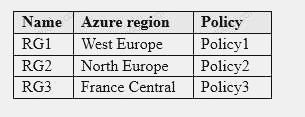
RG1 has a web app named WebApp1. WebApp1 is located in West Europe. You move WebApp1 to RG2. What is the effect of the move?
Answer: C
NEW QUESTION 16
Note: This questions is part of a series of questions that present the same scenario. Each questions in the series contains a unique solution that might meet the stated goals. Some questions sets might have more than one correct solution, while others might not have a correct solution. After you answer a questions in this section, you will NOT be able to return to it. As a result, these questions will not appear in the review screen.
Your company registers a domain name of contoso.com.
You create an Azure DNS zone named contoso.com, and then you add an A record to the zone for a host named www that has an IP address of 131.107.1.10.
You discover that Internet hosts are unable to resolve www.contoso.com to the 131.107.1.10 IP address.
You need to resolve the name resolution issue.
Solution: You create a PTR record for www in the contoso.com zone. Does this meet the goal?
Answer: B
Explanation: Modify the Name Server (NS) record.
References: https://docs.microsoft.com/en-us/azure/dns/dns-delegate-domain-azure-dns
NEW QUESTION 17
Note: This question is part of a series of Questions that present the same scenario. Each question in the series contains a unique solution that might meet the stated goals. Some question sets might have more
than one correct solution, while others might not have a correct solution. After you answer a question in this section, you will NOT be able to return to it. As a result, these questions will not appear in the review screen.
You have an Azure virtual machine named VM1. VM1 was deployed by using a custom Azure Resource Manager template named ARM1.json.
You receive a notification that VM1 will be affected by maintenance. You need to move VM1 to a different host immediately.
Solution: From the Overview blade, you move the virtual machine to a different resource group. Does this meet the goal?
Answer: B
NEW QUESTION 18
HOT SPOT
You plan to create a new Azure Active Directory (Azure AD) role.
You need to ensure that the new role can view all the resources in the Azure subscription and issue support requests to Microsoft. The solution must use the principle of least privilege.
How should you complete the JSON definition? To answer, select the appropriate options in the answer area.
NOTE: Each correct selection is worth one point.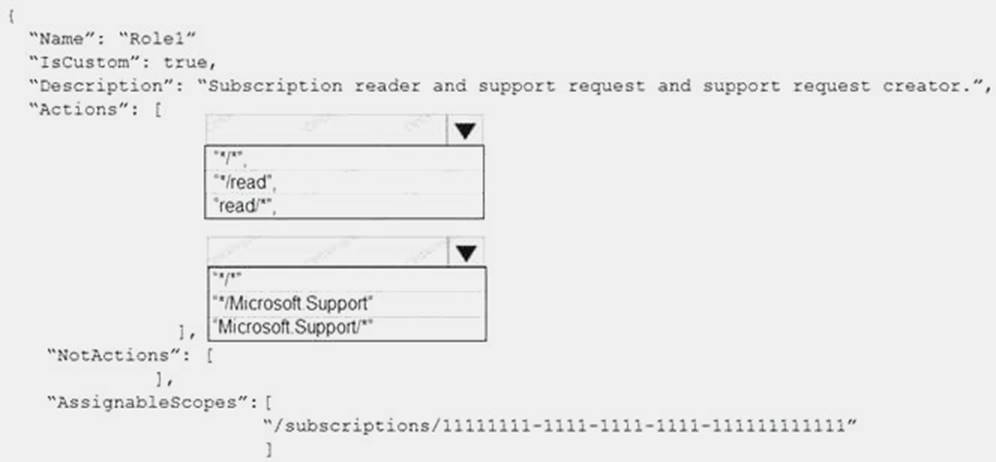
Answer:
Explanation: Box 1: "*/read",
*/read lets you view everything, but not make any changes. Box 2: " Microsoft.Support/*"
The action Microsoft.Support/* enables creating and management of support tickets. References:
https://docs.microsoft.com/en-us/azure/role-based-access-control/tutorial-custom-role-powershell https://docs.microsoft.com/en-us/azure/role-based-access-control/built-in-roles
NEW QUESTION 19
You discover that VM3 does NOT meet the technical requirements. You need to verify whether the issue relates to the NSGs.
What should you use?
Answer: E
Explanation: Scenario: Contoso must meet technical requirements including:
Ensure that VM3 can establish outbound connections over TCP port 8080 to the applications servers in the Montreal office.
IP flow verify checks if a packet is allowed or denied to or from a virtual machine. The information consists of direction, protocol, local IP, remote IP, local port, and remote port. If the packet is denied by a security group, the name of the rule that denied the packet is returned. While any source or destination IP can be chosen, IP flow verify helps administrators quickly diagnose connectivity issues from or to the internet and from or to the on-premises environment.
References:
https://docs.microsoft.com/en-us/azure/network-watcher/network-watcher-ip-flow-verify-overview
NEW QUESTION 20
You have an azure subscription that contain a virtual named VNet1. VNet1. contains four subnets named Gatesway, perimeter, NVA, and production.
The NVA contain two network virtual appliance (NVAs) that will network traffic inspection between the perimeter subnet and the production subnet.
You need o implement an Azure load balancer for the NVAs. The solution must meet the following requirements:
The NVAs must run in an active-active configuration that uses automatic failover.
The NVA must load balance traffic to two services on the Production subnet. The services have different IP addresses
Which three actions should you perform? Each correct answer presents parts of the solution. NOTE: Each correct selection is worth one point.
Answer: BCE
Explanation: A standard load balancer is required for the HA ports.
-Two backend pools are needed as there are two services with different IP addresses.
-Floating IP rule is used where backend ports are reused. Incorrect Answers:
F: HA Ports are not available for the basic load balancer. References:
https://docs.microsoft.com/en-us/azure/load-balancer/load-balancer-standard-overview https://docs.microsoft.com/en-us/azure/load-balancer/load-balancer-multivip-overview
P.S. Easily pass AZ-102 Exam with 195 Q&As 2passeasy Dumps & pdf Version, Welcome to Download the Newest 2passeasy AZ-102 Dumps: https://www.2passeasy.com/dumps/AZ-102/ (195 New Questions)